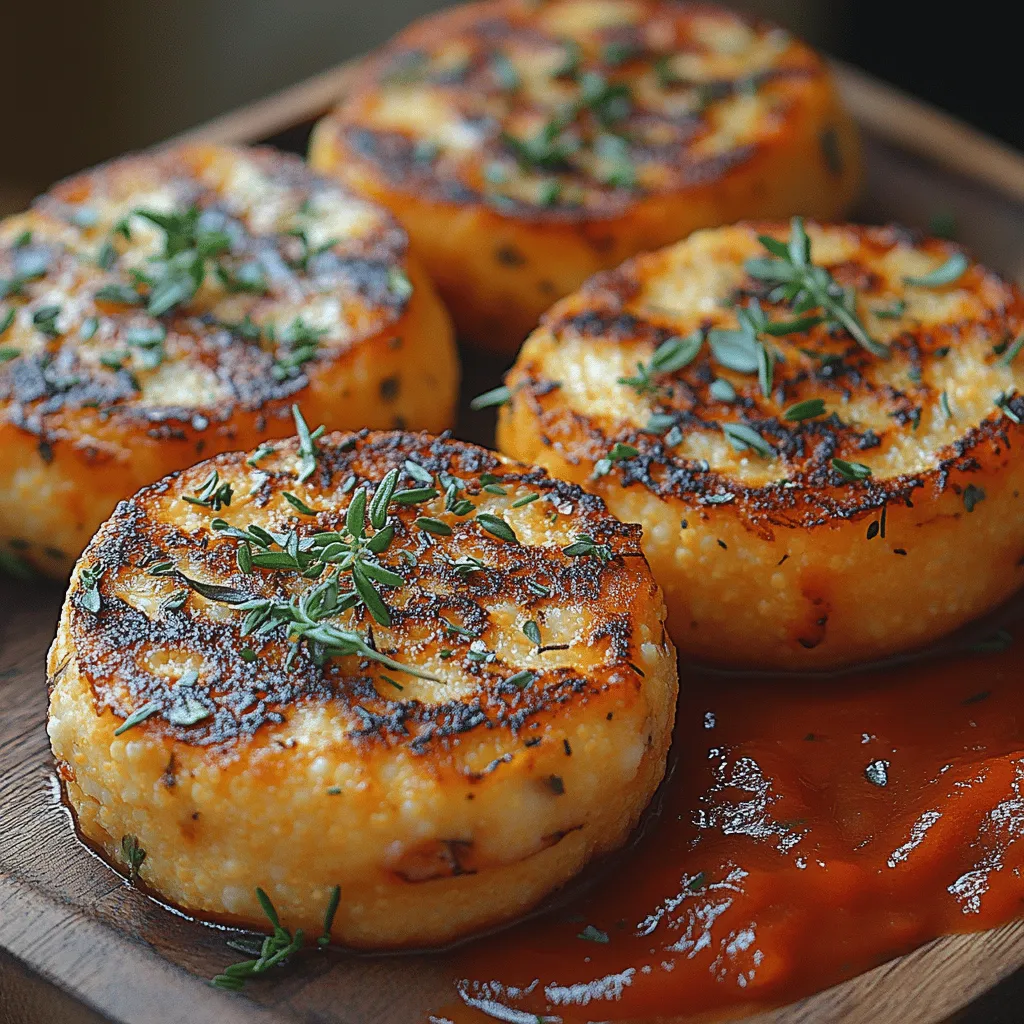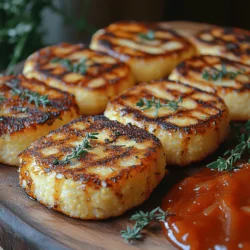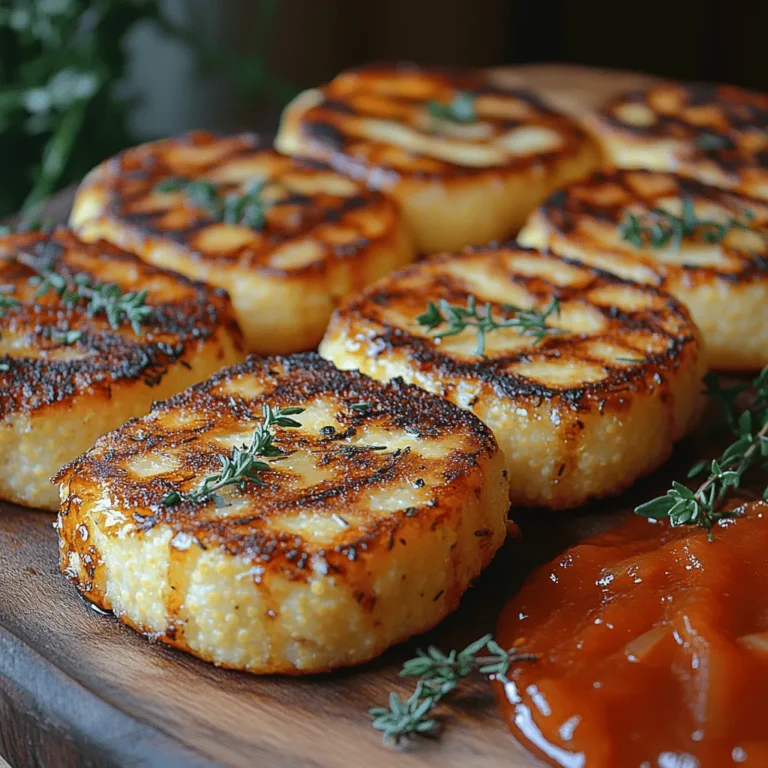Crispy Parmesan Polenta Cakes: A Delightful Culinary Experience
Polenta, a staple in Italian cuisine, has gained popularity around the world for its versatility and comforting nature. Made from ground cornmeal, polenta can be served creamy, baked, grilled, or fried, making it an adaptable base for a variety of dishes. One of the most delightful ways to enjoy polenta is through the recipe for Crispy Parmesan Polenta Cakes. This dish not only showcases the rich flavors of polenta but also offers a delightful balance of textures, making it an ideal choice for both appetizers and side dishes.
Crispy Parmesan Polenta Cakes are golden, crunchy on the outside, and creamy on the inside, delivering a satisfying bite that is hard to resist. The addition of Parmesan cheese enhances the dish’s flavor profile, adding a nutty richness that complements the cornmeal’s natural sweetness. Whether served alongside a hearty main course or enjoyed as a stand-alone snack with a dipping sauce, these polenta cakes are sure to impress.
Understanding Polenta
Polenta is a traditional Italian dish made from coarsely ground cornmeal. Its origins date back to ancient times when it was a staple food for peasants in Northern Italy. Over the centuries, polenta has evolved from a basic sustenance food into a gourmet ingredient, celebrated for its adaptability and ease of preparation.
Nutritionally, polenta is a gluten-free grain, making it a suitable option for those with gluten intolerances. It is a good source of carbohydrates, providing energy and fiber, while also being low in fat. Additionally, polenta can be fortified with vitamins and minerals, depending on the corn used. This makes it not only a filling option but also a healthy one.
When selecting polenta, it’s essential to consider the different types available in the market. Instant polenta, which cooks in just a few minutes, is convenient for quick meals, while traditional polenta requires a longer cooking time but yields a creamier and richer flavor. The choice ultimately depends on your time constraints and desired texture.
Polenta serves as a blank canvas, allowing for a myriad of flavors to be incorporated. You can infuse it with herbs, spices, or even cheese, enhancing its natural sweetness. The versatility of polenta means that it pairs well with a variety of ingredients, making it an excellent choice for creative cooks looking to experiment in the kitchen.
Ingredients Breakdown
To create the perfect Crispy Parmesan Polenta Cakes, it’s crucial to understand the role of each ingredient:
– Polenta: Choosing the right type of polenta is vital for achieving the desired texture. Traditional yellow cornmeal produces a more complex flavor and creamier consistency compared to instant options. Look for high-quality, stone-ground polenta for the best results.
– Vegetable Broth: The flavor of your polenta can be dramatically improved by the quality of the broth used. A rich vegetable broth adds depth and enhances the overall taste of the cakes, setting the foundation for a flavorful dish.
– Salt and Black Pepper: These simple seasonings are essential for enhancing the flavors of the dish. Salt brings out the natural sweetness of the corn, while black pepper adds a subtle heat that balances the richness of the cheese.
– Parmesan Cheese: This ingredient is key to achieving the creamy texture and savory flavor profile of the polenta cakes. Grated Parmesan melts beautifully into the polenta, providing a luxurious mouthfeel and a hint of nuttiness.
– Sour Cream vs. Greek Yogurt: While both ingredients can be used to add creaminess, they have distinct flavors. Sour cream offers a tangy note, while Greek yogurt provides a thicker texture and a slightly healthier profile. Choose based on your personal preference or dietary needs.
– Butter and Olive Oil: These fats contribute to the overall flavor and texture of the polenta. Butter adds richness, while olive oil lends a fruity note and helps achieve a crispy exterior when frying the cakes.
– Fresh Herbs: Fresh herbs like parsley, basil, or chives not only enhance the dish’s presentation but also add freshness and aroma. Incorporating herbs can elevate the polenta cakes, making them more vibrant and appealing.
– Optional Sauces: Serving the polenta cakes with sauces such as marinara or pesto can elevate the dish even further. These condiments add moisture and additional flavor, transforming the cakes into a more complete culinary experience.
Step-by-Step Guide to Making Crispy Parmesan Polenta Cakes
Preparing the Polenta
To begin making your Crispy Parmesan Polenta Cakes, start by bringing your vegetable broth to a gentle boil in a medium saucepan. The amount of broth will depend on the type of polenta you are using, so be sure to follow the instructions on the package for the best results.
Once the broth is boiling, gradually whisk in the polenta. This step is crucial—pouring the polenta in too quickly can lead to clumps. Continue to whisk vigorously as the polenta begins to thicken, ensuring there are no lumps. The key to a creamy polenta lies in the cooking method and stirring technique.
Cook the polenta over low heat for approximately 20 to 30 minutes, stirring frequently. This constant stirring helps to release the starches in the cornmeal, resulting in a smooth and creamy consistency. If the polenta becomes too thick, you can add a splash of additional broth or water to loosen it up.
Once the polenta reaches your desired creaminess, remove it from the heat and stir in the grated Parmesan cheese, butter, salt, and black pepper. This is where the magic happens; the cheese and butter will melt into the warm polenta, creating a rich and flavorful base.
After incorporating the ingredients, it’s important to chill the polenta before shaping it into cakes. Pour the mixture into a greased baking dish or a lined tray, spreading it evenly to about half an inch thick. Allow the polenta to cool at room temperature for about 30 minutes, then cover it with plastic wrap and refrigerate for at least 2 hours or until firm. This chilling process is vital for achieving the right texture when frying the cakes later on.
With the polenta properly prepared and chilled, you are now ready to transform it into delicious Crispy Parmesan Polenta Cakes. Stay tuned for the next steps, where we’ll guide you through the frying process and how to serve these delectable treats!

Why Chilling is Crucial for Slicing
Chilling your polenta is an essential step for achieving perfectly sliced polenta cakes. When polenta is cooked and then allowed to cool in a baking dish, it solidifies into a firm structure that is easy to cut. If you attempt to slice warm polenta, it will be too soft and likely fall apart, making it difficult to form cakes that hold their shape during cooking. Ideally, allow the polenta to chill for at least 2 hours in the refrigerator. For best results, overnight chilling is recommended. This not only enhances the texture but also deepens the flavors as the polenta absorbs the seasonings and cheese.
How to Properly Store the Polenta for Best Results
To store your leftover polenta properly, wrap it tightly in plastic wrap or transfer it to an airtight container. This helps prevent it from drying out and keeps it fresh. If you plan to use it later, chilling it in the refrigerator works best, but you can also freeze polenta for longer storage. When freezing, consider slicing it into portions before freezing, as this allows for easy reheating. Just remember to thaw it in the refrigerator before reheating for optimal texture.
Cutting and Shaping the Polenta
Techniques for Achieving Even Shapes
Once the polenta has chilled and set, it’s time to cut and shape it into cakes. To achieve even shapes, use a sharp knife or a pizza cutter. Make sure to wet the blade with water to prevent sticking. Cut the polenta into squares, rectangles, or circles, depending on your preference. For circles, a round cookie cutter works perfectly. The key is to maintain uniform thickness—about 1/2 inch is ideal for achieving the perfect balance between crispy edges and a creamy interior.
Suggestions for Different Forms
You can get creative with the shapes of your polenta cakes. While squares and rectangles are classic, circles offer an elegant touch, making them perfect for appetizers. You can also try cutting them into triangles for a more rustic feel. For themed gatherings, consider using cookie cutters in fun shapes like hearts or stars, especially for children’s parties. The versatility of polenta allows for various presentations that can suit any occasion.
Pan-Frying the Cakes
Ideal Heat Levels for Frying
When it comes to frying your polenta cakes, temperature control is critical. Start with medium heat to allow the cakes to crisp up nicely without burning. Once the oil is hot enough (you can test this by dropping a small piece of polenta in; it should sizzle), lower the heat slightly to medium-low. This will help cook the cakes evenly, ensuring that the insides become warm and creamy while the outsides turn golden and crispy.
How to Achieve a Crispy Exterior Without Burning
To achieve that sought-after crispy exterior, make sure not to overcrowd the pan. Frying too many cakes at once can drop the oil temperature, resulting in soggy polenta instead of crispy cakes. Fry in batches if necessary, allowing each cake to have adequate space. Cook for about 3-4 minutes on each side or until they reach a deep golden brown color. If you notice they are browning too quickly, reduce the heat further.
Maintaining the Right Balance Between Butter and Olive Oil
For frying, a combination of butter and olive oil works wonders. Olive oil has a higher smoke point and imparts flavor, while butter adds richness and helps achieve that golden color. A ratio of 2:1 olive oil to butter is typically recommended. Start with the olive oil in the pan, and once it’s hot, add the butter. This method gives you the best of both worlds—flavor and the ability to fry at the right temperature without burning.
Serving Suggestions
Creative Ways to Serve Crispy Parmesan Polenta Cakes
Crispy Parmesan polenta cakes are incredibly versatile and can be served in various ways that elevate your meal. For a simple yet delightful option, serve them topped with a sprinkle of fresh herbs like basil or parsley. For a heartier dish, stack a few cakes with sautéed vegetables or grilled meats. You can also create a layered polenta stack with alternating layers of polenta, cheese, and roasted tomatoes for a more gourmet presentation.
Pairing with Marinara Sauce or Pesto
One of the most delicious ways to enjoy polenta cakes is to serve them with a side of marinara sauce or pesto. The bright acidity of marinara complements the rich, cheesy polenta, making for a delightful contrast. If you want a fresher flavor, homemade or store-bought pesto can also be a great pairing, drizzled on top or served on the side. The addition of a creamy sauce like Alfredo can also bring an indulgent twist to your dish.
Serving as an Appetizer at Gatherings or Parties
Crispy polenta cakes make for excellent appetizers at gatherings or parties. They can be served on a platter with various dips, such as tzatziki, hummus, or a spicy aioli, allowing guests to customize their bites. Alternatively, you can top each polenta cake with a slice of smoked salmon or a dollop of crème fraîche for an elegant touch. Garnishing with microgreens or edible flowers can also add visual appeal.
Incorporating Polenta Cakes into Main Dishes
Incorporating polenta cakes into your main dishes is another fantastic way to enjoy this recipe. Use them as a base for a protein of your choice, like grilled chicken or sautéed shrimp, drizzled with a savory sauce. They can also substitute for traditional pasta, served alongside a rich ragu or a hearty vegetable stew. The flavor and texture of the polenta cakes will complement the dish beautifully, making it a satisfying meal.
Nutritional Insights
Overview of the Dish’s Nutritional Profile
Crispy Parmesan polenta cakes offer a delightful balance of flavors and textures, and they can fit into a nutritious diet. Polenta is primarily made from cornmeal, which is a gluten-free grain that provides complex carbohydrates. Each serving can contain around 150 calories, with a good amount of fiber, especially if you choose whole grain polenta. The addition of Parmesan cheese enhances the protein content while adding essential vitamins and minerals.
Health Benefits of Key Ingredients
Polenta itself is rich in antioxidants and provides essential nutrients like vitamin B6, iron, and magnesium. The Parmesan cheese adds calcium and protein, contributing to bone health and muscle maintenance. When prepared with healthy fats like olive oil, you also gain heart-healthy monounsaturated fats. This dish can be a wholesome option for vegetarians looking for filling, nutrient-dense meals.
How to Modify the Recipe for Dietary Restrictions
For those with dietary restrictions, this recipe can be easily modified. To make it gluten-free, ensure you use certified gluten-free cornmeal. For a dairy-free version, substitute the Parmesan cheese with nutritional yeast for a similar cheesy flavor without the lactose. You can also explore using vegan butter or olive oil for frying. By adjusting ingredient ratios, you can create a version that aligns with various dietary preferences while still delivering on taste.
The Cultural Significance of Polenta
Polenta in Global Cuisines
Polenta has a rich history and cultural significance in various cuisines around the world. Originating from Italy, it has become a staple in many regions, often associated with rustic, home-cooked meals. In Northern Italy, polenta is often served as a comforting dish alongside stews or grilled meats. However, its versatility has allowed it to spread across cultures, with adaptations seen in South American, African, and even Asian cuisines.
Regional Variations and Traditional Dishes Featuring Polenta
Across Italy, you can find numerous regional variations of polenta dishes. In the Veneto region, it is often served with a rich fish stew, while in Lombardy, polenta is sometimes incorporated into risottos. In Brazil, polenta is known as “polenta de milho” and can be found in street food, served with cheese and sauces. The adaptability of polenta allows it to take on local flavors, making it a beloved dish in many households.
Personal Anecdotes or Stories Related to Polenta and Its Preparation
For many, polenta is not just a dish but a nostalgic comfort food that evokes memories of family gatherings and traditions. Many home cooks recall the process of stirring the polenta as it cooks, often done with family members sharing stories and laughter. The slow, deliberate preparation of polenta often fosters a sense of community, making it a dish that brings people together.
Conclusion
Crispy Parmesan polenta cakes are not just a delightful dish; they represent the joy of cooking and the satisfaction of creating something from scratch. The simplicity of polenta combined with the rich flavors of Parmesan cheese makes this dish a winner in any kitchen. Whether you choose to serve them as a side, an appetizer, or a main dish, the versatility of polenta allows for endless creativity in the kitchen.
As you explore the world of polenta, consider its potential as a staple in your cooking repertoire. With its rich history and cultural significance, polenta is more than just food; it’s a celebration of flavors, textures, and traditions. So, roll up your sleeves, get cooking, and enjoy the delightful experience of making and sharing crispy Parmesan polenta cakes with family and friends.


